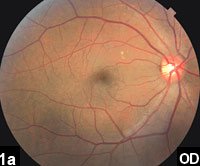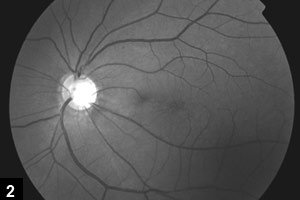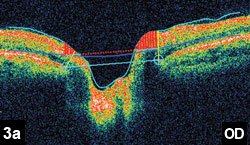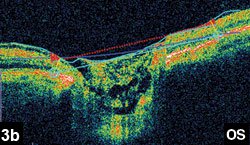Man presents with gradual worsening of vision in left eye
Abnormalities of the optic nerve head and mottling of the retinal pigment epithelium were observed in the left eye.

A 46-year-old Asian man was referred to the retina service at the New England Eye Center for evaluation and management of his decreasing vision. He had first noted some blurriness of the vision out of his left eye about 2 years ago, and despite multiple visits to the optometrist, his visual acuity was unable to be improved with spectacles. He felt that his left eye had always been “weaker” than his right eye, but not to such a significant degree as recently.
When asked to describe the quality of his vision, he said that while there was an overall haziness, there was also a bit of distortion in the center of his focus. He denied any eye pain, flashes or floaters in his vision. He was otherwise healthy with no medical problems, and he was not on any medications. He had no other history of ocular disease.
 Isabel M. Balderas |  Tom Hsu | ||
Examination
On examination, the patient’s best corrected visual acuity by Snellen chart was 20/20 in the right eye and 20/200 in the left eye. IOP by applanation was 17 mm Hg bilaterally. Pupils were equally round and reactive without an afferent pupillary defect. Visual fields by confrontation were intact, and extraocular movements were full. On slit lamp examination, the anterior chambers of both eyes were quiet, and there were mild nuclear sclerotic cataracts noted in both eyes. Photos from the dilated funduscopic exam are shown in Figure 1a, with a close-up of the optic nerve of the left eye in Figure 1b. A red-free photograph of the left eye is shown in Figure 2.
 |
 |
 |
Color fundus photographs (1a)
of the eyes. Close-up (1b) of the left optic nerve head. Images: Hsu T, Duker JS |
 Red-free photograph of the left eye. There is mottling of the retinal pigment epithelium, as well as profound abnormalities of the optic nerve head. |
|

What is your diagnosis?
Optic nerve head
The most notable funduscopic finding in this patient was the anomalous appearance of the optic nerve in the left eye. The distribution and location of the vasculature arising from the optic nerve head differ significantly from the unaffected eye. In addition, under stereoscopic biomicroscopy, the haze overlying the optic nerve head extended into the vitreous. A closer examination of the macula of the left eye showed a mottled appearance to the retinal pigment epithelium, but no clear fluid demarcation.
Differential diagnosis
In considering the appearance of the optic nerve head, several differential diagnoses come to mind. Bergmeister’s papilla, as a remnant of the hyaloid stalk, would result in a fibrotic tissue overlying the optic nerve head. However, this would not explain the vascular pattern seen. Another benign condition, oblique insertion of the optic nerve head, may actually result in an apparent distortion of the insertion points of the blood vessels into the optic nerve. Arguments against this would be the lack of peripapillary atrophy typically seen with this condition. Other diagnoses to consider include optic nerve pits and colobomas. With the optic nerve pit, which can be acquired or congenital, the defect in the optic nerve head usually appears as a specific area of depression outside of the physiologic cup. This depression typically has a well-demarcated appearance and may be associated with a peripapillary subretinal fluid collection and/or macular schisis. In terms of an optic nerve coloboma, which is a result of incomplete closure of the embryonic fissure, clinical features include a sharply demarcated defect, usually inferiorly, in the optic nerve head. Sectoral paleness, corresponding to the underlying choroid adjacent to the optic nerve, can often be seen, and limited peripapillary atrophy is present at the site of the coloboma. We did not observe these features in our patient.
Another condition that results in an abnormal appearance to the optic nerve head would be morning glory anomaly. In this congenital condition, the main characteristics are an enlarged optic nerve head coupled with a peripapillary staphyloma that results in a funnel-like excavation of the optic nerve. In a majority of cases, the anomalous optic nerve head is covered with a glial-like fibrotic tissure that often projects substantially into the vitreous. An optical coherence tomography scan of the optic nerve head in our patient demonstrated this fibrotic tissue clearly (Figure 3). However, what truly distinguished this condition was the pattern of the vessels arising from the optic nerve head. Like the namesake flower, the morning glory, the blood vessels were typically straightened and exit the nerve head radially and circumferentially. While there appears to be different levels of penetrance in this condition, the radial insertion of the blood vessels was considered pathognomonic for the anomaly.
Discussion
|
| Optical coherence tomography of the optic nerve heads. Note that in the left eye there is increased signal reflectivity over the nerve, reflecting the preretinal fibrotic tissue. |
As this is a rare condition, there are few studies looking at the epidemiology of morning glory anomaly. What has been reported so far is a 2:1 predominance of women over men. This is a congenital disorder but can often be overlooked in cases in which there is incomplete penetrance. In terms of genetics, no clear inheritance pattern has been observed. There are two isolated case reports of father-son pairs, but most cases appear to be sporadic. Only one case of morning glory anomaly has been correlated with a PAX-6 gene defect, which has also been implicated in ocular conditions such as aniridia, anophthalmia and congenital cataracts, among others. Clinically, the anomalous optic nerve is typically seen unilaterally, although a few bilateral cases exist in the literature. The visual acuity in patients typically ranges from 20/100 to hand motion, and there seems to be a slow decline in vision as time goes on. An unknown percentage of the visual disability results from amblyopia in childhood, but it does not appear that occlusion therapy provides a significant benefit to long-term visual potential.
Some of the more significant complications associated with this condition include strabismus, microphthalmos, and retinal breaks and detachments surrounding the anomalous disc. Capillary hemangiomas within the retina, the orbit and in the central nervous system have also been reported. Some of the earlier reports describing the anomaly noted an increased association with sphenopharyngeal meningoencephaloceles, as well as being part of other systemic syndromes, such as neurofibromatosis type 2. Of particular interest is an association with vascular abnormalities, often manifested as moyamoya disease. In this extremely rare condition, there is progressive stenosis of the circle of Willis with subsequent ischemic events. This can afflict patients of any age group, with particularly devastating consequences in the pediatric population. Currently, there is no consensus as to the cost-effectiveness of screening patients with morning glory anomaly for moyamoya disease.
As there is no treatment for morning glory anomaly at this time, the patient was provided with information regarding the condition and scheduled for routine follow-up visits in our clinic.
For more information:
- Tom Hsu, MD, and Jay S. Duker, MD, can be reached at New England Eye Center, Tufts University School of Medicine, 750 Washington St., Box 450, Boston, MA 02111; 617-636-4219; fax: 617-636-4866; Web site: www.neec.com.
- Edited by Isabel M. Balderas, MD, and Tom Hsu, MD. Drs. Balderas and Hsu can be reached at New England Eye Center, Tufts University School of Medicine, 750 Washington St., Box 450, Boston, MA 02111; 617-636-4219; fax: 617-636-4866; Web site: www.neec.com. Drs. Balderas and Hsu have no direct financial interest in the products mentioned in this article, nor are they paid consultants for any companies mentioned.
References:
- Deb N, Das R, Roy IS. Bilateral morning glory disc anomaly. Indian J Ophthalmol. 2003;51(2):182-183.
- Fernandez-Fernandez S, Vazquez-Lopez M, et al. [An association between moya-moya disease and morning glory anomaly.] Rev Neurol. 2003;37(6):541-544. Spanish.
- Ho CL, Wei LC. Rhegmatogenous retinal detachment in morning glory syndrome pathogenesis and treatment. Int Ophthalmol. 2001;24(1):21-24.
- Kindler P. Morning glory syndrome: Unusual congenital optic disk anomaly. Am J Ophthalmol. 1970;69(3):376-384.
- Krishnan C, Roy A, Traboulsi E. Morning glory disk anomaly, choroidal coloboma, and congenital constrictive malformations of the internal carotid arteries (moyamoya disease). Ophthalmic Genet. 2000;21(1):21-24.
- Lenhart PD, Lambert SR, et al. Intracranial vascular anomalies in patients with morning glory disk anomaly. Am J Ophthalmol. 2006;142(4):644-650.
- Murphy MA, Perlman EM, et al. Reversible carotid artery narrowing in morning glory disc anomaly. J Neuroophthalmol. 2005;25(3):198-201.
- Sinivasan G, Venkatesh P, Garg S. Optical coherence tomographic characteristics in morning glory disc anomaly. Can J Ophthalmol. 2007;42(2):307-309.


